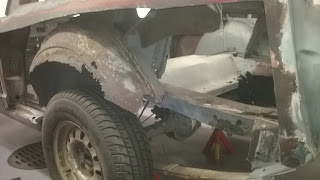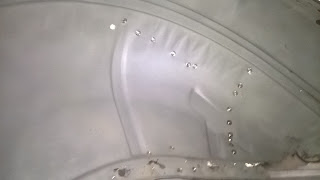According the door tag axle digit "A" the car rolled out from factory with Equa-Lock limited-slip differential (LSD) and 3.00:1 gear ratio. Equa-lock was used by Ford until '67 when it was later replaced with their Traction-Lok. I never paid any attention to the rearend until it was time to drop the axle for rear sheet metal repairs.
 |
| Horizontal ribs tell us this is '62-'66 case |
The rear axle that was had no identification tag left so it is hard to say if the 3rd member was original. The carrier looked like the casting (C20W-4025-F) Ford used in 8" rearends from '62 to '66 and had yellow handwritten "3" on it. When rotating the wheel one side the other side wheel turned in opposite direction. This was the first clue that the rearend would not be locking. When the case was pulled from the axle this was easily confirmed by visual check. This one is an open rearend most likely replacement from an other car of same period.
| Carrier casting number | C20W-4025-F | |
| Carrier casting date | 3J24 |
 |
| Ring gear bolt heads reveal it - an open differential |
 |
| Pinion shaft is cut in pieces |
 |
| Gear pinion pilot shaft |
To summarize it, the gears (3.25:1) had bad toothing, the pinion shaft was broken in pieces, the pinion and side gears had had their share of chips of metal rolling in between, gear pinion shaft (that enters gear pinion pilot bearing) was worn out, the pilot bearing was loose, the other bearings had seen better days. So, this rearend was shot ! Maybe the last burnout was too much.
Knowing that the necessary parts would cost me close to 1000 €, I checked FMOC message board, if there were any usable rearends available. A fellow FMOC member contacted me and offered to rebuild me a differential to my specification. The price was very feasible, so I took the chance and decided to go with street version of Yukon's limited slip. A couple of weeks later he delivered and collected my old case in return.
The "new" case consists of:
| Carrier case | C70W-4025-A | ||
| Differential | Yukon Duragrip | p/n YDGF8-28-SM | |
| Gears | 3.25:1 Strange | p/n RS07880325US |
Very nice looking pumpkin, isn't it. All new gears and bearings were installed and everything shimmed and adjusted to the specifications. It will only need another coat of red oxide prior to be installed in the axle housing.
An article on rebuilding a Ford 8" on Mustang360 if you want to DIY.













































